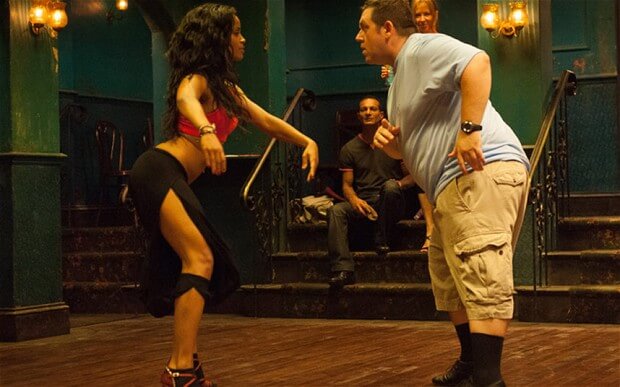When I tell colleagues I am going to meet the UK’s pre-eminent dance psychologist, they are infuriatingly less interested in his pre-eminence than they are in knowing what exactly a dance psychologist is.
Can Peter Lovatt, aka The Dance Doctor, heal childhood trauma with a well-rehearsed tango? Is he on call to weddings to deal with the fall-out from dad-dancing? Or has he discovered through his research that the Hokey Cokey really is what it’s all about?
The answer to all three is no, explains Dr Lovatt, who has come from an afternoon practising his jazz dance at London’s Pineapple Studios. Put simply, the Dance Psychology Laboratory at the University of Hertfordshire, which he founded in 2008, has two aims: to research how dance can affect our mood and well-being as well as how people relate to it, and then use that research to help us get over our hang-ups around dancing – whether it be in nightclubs, parties or classes.

Peter Lovatt: ‘We’re all rhythmic beings’
Dr Lovatt understands only too well the hang-ups so many of us have, especially men. Despite training in dance and musical theatre as a student and still taking up to eight classes a week, the 49-year-old academic admits he sometimes lacks confidence in his moves. “I still have those feelings that I’m too old for this, that I’m in the wrong shape, that I don’t have the right agility level. So I do understand where other men who are not trained dancers come from. It can be a very intimidating thing.”
Of course it’s intimidating, because it’s a jungle out there on the dance floor. Through Dr Lovatt’s own and others’ research he has shown that men with higher prenatal testosterone levels really do dance differently from men who were exposed to lower levels of the hormone in the womb. And unsurprisingly, it’s the moves of the high-testosterone males that female potential partners find the most attractive.
“We did tests where we’d check men’s prenatal testosterone levels by the length of their index finger compared to their ring finger. The longer their ring finger is in comparison to the index, the higher the level of testosterone they’re thought to have been exposed to,” he explains. “Then we filmed the men dancing naturally. We played this footage back, blurred out on a screen, so women couldn’t tell how physically attractive thee men were. They could only see the moves, and the women consistently rated the higher testosterone men as better dancers and more attractive.”
Dr Lovatt says low-testosterone dancing involves small movements, generally keeping within the frame of the body. High-testosterone men, however, co-ordinate bigger movements in different parts of their body, making their outline more interesting and spectators keener to watch them for longer (previous articles about his research have suggested he advocates dancing like John Travolta in Saturday Night Fever). They also tend to break up the rhythm of the music, rather than dancing solidly to the beat.
John Travolta demonstrates his best high-testosterone dancing
So can we all dance like alphas, now we know their secrets? “Absolutely, I could show you how to dance in this way now and you could go out to a club tonight and do it,” he says.
“But you may not want to do that. Because it isn’t the case that high testosterone is good and low testosterone is bad. You need to dance in a way that feels natural to you. You might fake it on the dance floor and attract a mate that way, but if you get into bed you’ll probably find you’re not compatible when you’re moving most naturally, when you’re making love.”
The real secret is feeling confident with your own dancing style, which the psychologist has found comes easier to men at different times in their lives. According to a study of 14,000 people of different ages who were asked to rate their dancing in comparison with their peers, men have very low confidence in their own abilities immediately after puberty – much lower than women at the same stage – though this confidence gradually increases up to the age of 35 and then plateaus until around 65, when it suddenly rockets.
“At 65 men stop peacocking,” he says. “When you watch older men dance, they often have a relaxed confidence about the way they move, there’s no showing off any more. Women’s confidence tends to drop at around 55 and the menopause, so this is the first time in their lifespan that men feel more comfortable moving than women.”
To tap into this confidence, Dr Lovatt recommends lying down by your yourself, tuning the radio to a music station and making a small, improvised movement to the rhythm. “Then, over the course of a few pieces of music, let that twitch get bigger, move it around your body – through your stomach, chest, shoulders, down to your groin, your legs and up into your arms and head – until you’re making full movements. The important thing is to let it grow out of you, so it’s your natural rhythm. It sounds new age but it’s not in the least.”
And what about people who claim to have no rhythm? “We’re all rhythmic beings. Your heart beats in a rhythm, your brain functions in a rhythm. You’ve just got to find it.”
He adds: “Men sometimes say they’ve got no rhythm as an excuse, because they think dancing’s not for them. Well, it is, it’s a display thing. Men should dance, and the more manly they are, the more they should dance.”
Source link: https://www.telegraph.co.uk/men/active/10664623/How-to-dance-like-an-alpha-male.html

